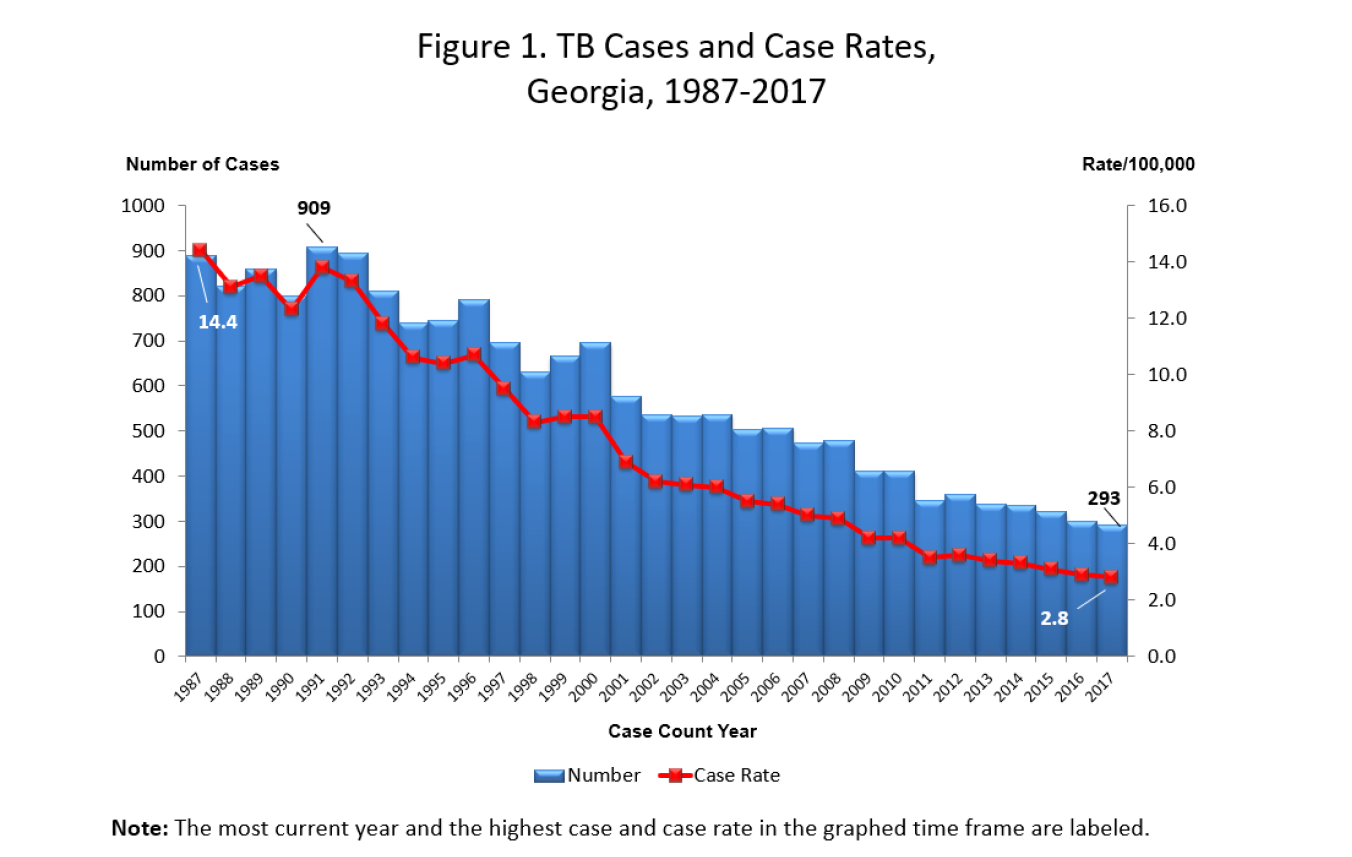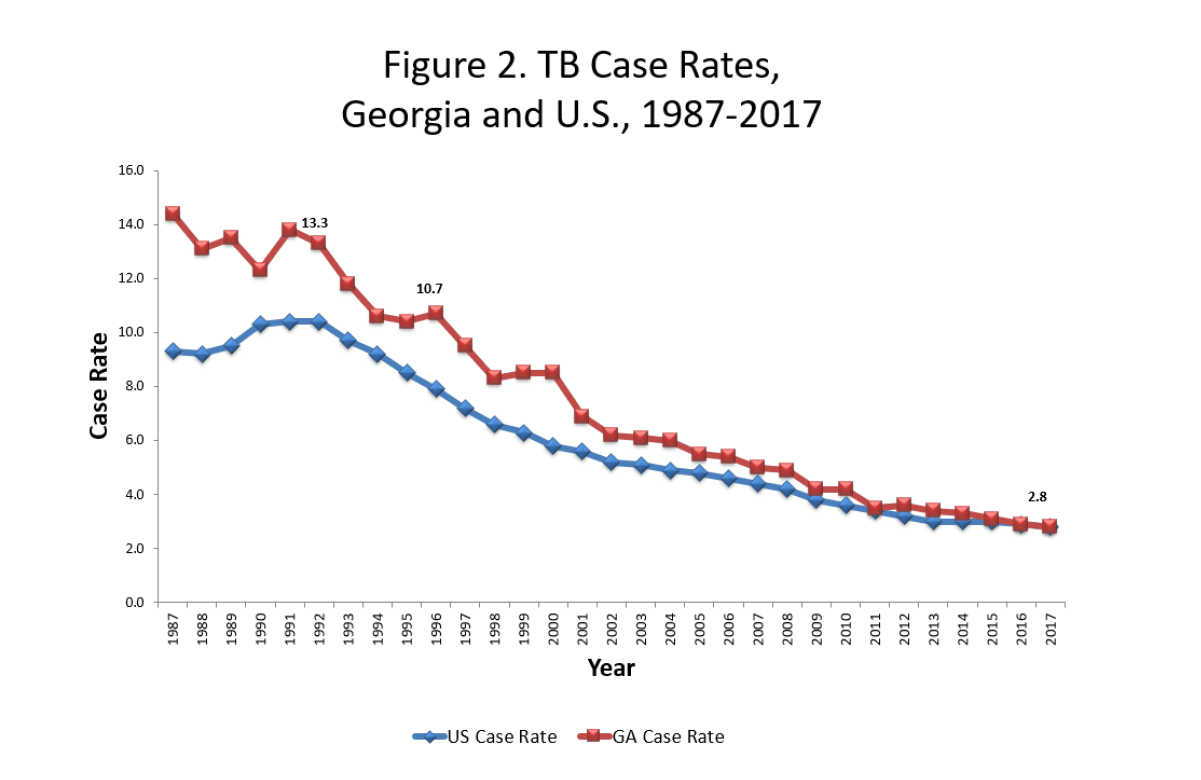Tuberculosis, a widespread disease, which often affects the human lungs and leads to severe consequences, is an essential problem for scientists. Caused by a bacterium such as Mycobacterium tuberculosis, the disease is transmitted through the air (“What is TB”, 2018). A person can get infected from another human when talking, coughing, sneezing, or using household items that were used by the patient with the disease.
There is still no drug that would ensure the recovery from the infection. This essay will summarize the history of tuberculosis up to current days and will show statistical data on the number of cases in Georgia since 1980. The situation will be discussed further with an explanation of the significance of a level of affected people.
Tuberculosis has accompanied humanity for thousands of years across countries. Its characteristic tissue changes are found in human remains dating back to about 5000 BC (the Neolithic period) and in Egyptian mummies, according to data (Barberis et al., 2017). In Ancient Greece, the disease was called “phthisis”; the etymology of this word indicates exhaustion as stated in articles (“History of World TB Day,” 2016, para. 13). In the works of Hippocrates and Avicenna, there are descriptions of acute and chronic lung diseases with such features as pulmonary bleeding, severe coughing, loss of strength, and extensive intoxication.
A breakthrough in understanding the nature of tuberculosis occurred in the XIX century. In 1819, the French researcher Rene-Theophile Laennec described a tubercle, or granuloma, as well as caseous necrosis, that is, dead lung tissue (Barberis et. al., 2017). These two findings became the main signs of tuberculosis for professionals. The discovery of the causative agent of disease belongs to the German microbiologist Robert Koch, who discovered Mycobacterium tuberculosis in 1882 (“History of World TB Day,” 2016). The vaccine appeared 36 years later; in 1918, French scientists Calmette and Guerin discovered the BCG (TB) vaccine, and the first vaccination was made three years later — to a newborn (Barberis et. al., 2017). To this day, BCG (TB) remains the only available vaccine for tuberculosis.
Highlighting development was made in the end of the twentieth century. In 1985, German physicist Wilhelm Roentgen discovered X-rays for tuberculosis diagnosis, for which he was awarded the Nobel prize (“History of World TB Day,” 2016). In 2000, 53 million people recovered due to effective drugs, the World Health Organization (WHO) reports (“What is TB”, 2018). In 2014, the World Health Organization (WHO) adopted a resolution approving a new strategy to eliminate the global tuberculosis epidemic by 2035 (“WHO End TB Strategy,” n.d.).
However, according to various data, today, a third of the world’s population has a latent Koch’s bacillus (“Tuberculosis,” 2019). Up to five thousand people continue to die from tuberculosis every day, as stated by the WHO (“Tuberculosis,” 2019). The data means that the global burden of tuberculosis is quite high.
There is a broad data on the tuberculosis situation in the United States that is tracked by authorities nowadays. The Department of Health and Human Services of the US stated that in 1983, a level of 10.2 tuberculosis cases per 100,000 population was registered (“Current Trends Tuberculosis,” 1984). However, in some urban cities, such as in Atlanta, Georgia, the rate was three times higher than that on the country level. It is also suggested by researchers that in 1997 there were more patients with tuberculosis than in 1980 (Sotir et. al., 1999). However, the national rate in the US was 40% higher in 1980, which emphasized the severity of the situation.
2017 Georgia Tuberculosis Report presents precise data on the tuberculosis statistics from 1987 to 2017. The information in Figure 1 shows the cases in Georgia state through the years. Figure 2 indicates the comparison between the statics in Georgia and federal cases in the US (O’Neal et.al., 2017). It can be stated that between 1987 and 2000, tuberculosis figures in Georgia were significantly higher than in the US; however, to 2017, the rate in Georgia decreased to national levels. In 2018, Georgia reported 272 cases with a rate of 2.6, which is the sixth in the US and the twelfth state in the country (“Tuberculosis Cases,” 2019). The recent figures indicate quite a high level of disease spread in Georgia.


Overall, one can say that the level of disease dissemination in Georgia is quite high in contrast to other states of the US. This situation can be explained, for instance, by the lack of vaccination that should be provided for all newborns. The figures are significant because they might mean that the authorities and medical professionals do not work efficiently enough to prevent new cases and provide vaccination.
It might also be claimed that some regions of Georgia are suffering from low socioeconomic situation, which might be a side cause provoking tuberculosis. Furthermore, there might be risk features associated with tuberculosis, such as HIV infection dissemination, dangerous healthcare services, and correction facilities, suggested by the Centers for Disease Control and Prevention of Georgia (“Epidemiology of Tuberculosis,” 2019). Therefore, as there is no medication against tuberculosis that ensures full recovery, people with the disease can infect others without knowing it and spread the disease further.
To conclude, one might claim that a specific situation with tuberculosis that is happening in Georgia is disturbing. In comparison to other US states, the number of cases in the region is relatively high, but the trend is showing a substantial decrease in illness’ distribution. Nonetheless, it is essential to prevent the disease and reassure that people get mandatory vaccination against tuberculosis and safe healthcare services in state organizations that are in high-risk settings.
References
Barberis, I., Bragazzi, N., Galluzzo, L., & Martini, M. (2017). The history of tuberculosis: from the first historical records to the isolation of Koch’s bacillus. Journal of Preventive Medicine and Hygiene, 58(1), 9–12.
Current trends tuberculosis – United States. (1984). Web.
Epidemiology of Tuberculosis. (2019). Web.
History of World TB Day. (2016). Web.
O’Neal, P., Rustin, C., Drenzek, C., Wells, J., Perrymon, A., Ko, J., & Yarn, B. (2017). 2017 Georgia tuberculosis report. Web.
Sotir, M., Parrot, P., Metchock, B., Bock, N., McGowan, J., Ray, S., … Blumberg, H. (1999). Tuberculosis in the inner city: Impact of a continuing epidemic in the 1990s. Clinical Infectious Diseases 29(5), 1138-44. Web.
Tuberculosis. (2019). Web.
Tuberculosis cases and case rates per 100,000 population. (2019). Web.
What is TB? How is it treated? (2018). Web.
WHO End TB strategy. (n.d.) Web.